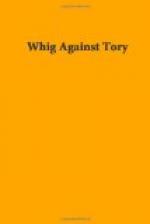“Being formed in order of battle, the intrepid officers led them to the attack. As they advanced, the guns of the fort poured in upon them a tremendous fire. This they met manfully, and, though some fell, the others seemed the more determined. But, just as they were beginning the attack in good earnest, a concealed body of Indians rose upon them, and the appalling war whoop broke upon their ears.”
[Illustration]
“This savage yell they had never before heard—such a sight they had never before witnessed. For a moment, alarm spread through the ranks. But courage—action was now necessary. Death or victory was before them. The officers called them to rally—to stand their ground—and they did so. They opened a well directed fire upon their savage foes, and only a short time passed before the latter were glad to retreat.
“The savages having retired, the men were ordered to throw up a breast work, near the place, to shelter themselves from the guns of the fort. This was done expeditiously. Trees were felled, and drawn to the spot by some; while others were employed in throwing up earth.
“During these labours of the Americans, the enemy continued to annoy them, by throwing shells from the fort.”
William. “Pray, father, what are shells? I have read of them; but I do not know more than that they are a kind of shot.”
Gen. P. “Shells are often called bombs, a word which signifies great noise; because, when they burst, they make a great noise. They consist of a large shell of cast iron, which is round and hollow. A hole is made through the shell to receive a fusee, as it is called; this is a small pipe, or hollow piece of wood, which is filled with some combustible matter. When a bomb is about to be fired, it is filled with powder, after which the fusee is driven into the vent, or hole of the shell.”
William. “How are bombs fired, father?”
Gen. P. “They are thrown from a kind of cannon called a mortar. It has its name from its resemblance to a common mortar. The lower part of the mortar is called the chamber, which contains the powder. When fired, the powder in the chamber not only sends the bomb, but at the same time, sets fire to the fusee, which continues to burn slowly, as it passes through the air, and the calculation always is, to have the fire from the fusee reach the powder in the shell, at the moment the latter reaches the ground. It then bursts, and the scattering fragments of iron often do horrible execution.”
William. “Did you say, father, that mortars Were short guns?”
Gen. P. “Land mortars are quite short; sea mortars, or such as are used on board vessels, are longer and heavier, because they are usually fired at greater distances. A land mortar, which will throw a shell thirteen inches in diameter, weighs thirteen hundred weight; the weight of the shell is about one hundred and seventy-five pounds; it contains between nine and ten pounds of powder; and is fired by means of about the same quantity of powder.”




